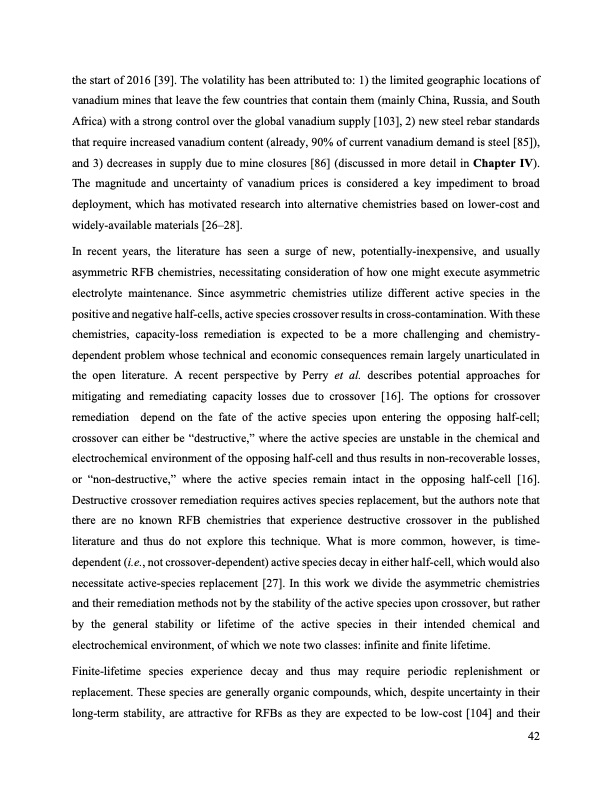
PDF Publication Title:
Text from PDF Page: 042
the start of 2016 [39]. The volatility has been attributed to: 1) the limited geographic locations of vanadium mines that leave the few countries that contain them (mainly China, Russia, and South Africa) with a strong control over the global vanadium supply [103], 2) new steel rebar standards that require increased vanadium content (already, 90% of current vanadium demand is steel [85]), and 3) decreases in supply due to mine closures [86] (discussed in more detail in Chapter IV). The magnitude and uncertainty of vanadium prices is considered a key impediment to broad deployment, which has motivated research into alternative chemistries based on lower-cost and widely-available materials [26–28]. In recent years, the literature has seen a surge of new, potentially-inexpensive, and usually asymmetric RFB chemistries, necessitating consideration of how one might execute asymmetric electrolyte maintenance. Since asymmetric chemistries utilize different active species in the positive and negative half-cells, active species crossover results in cross-contamination. With these chemistries, capacity-loss remediation is expected to be a more challenging and chemistry- dependent problem whose technical and economic consequences remain largely unarticulated in the open literature. A recent perspective by Perry et al. describes potential approaches for mitigating and remediating capacity losses due to crossover [16]. The options for crossover remediation depend on the fate of the active species upon entering the opposing half-cell; crossover can either be “destructive,” where the active species are unstable in the chemical and electrochemical environment of the opposing half-cell and thus results in non-recoverable losses, or “non-destructive,” where the active species remain intact in the opposing half-cell [16]. Destructive crossover remediation requires actives species replacement, but the authors note that there are no known RFB chemistries that experience destructive crossover in the published literature and thus do not explore this technique. What is more common, however, is time- dependent (i.e., not crossover-dependent) active species decay in either half-cell, which would also necessitate active-species replacement [27]. In this work we divide the asymmetric chemistries and their remediation methods not by the stability of the active species upon crossover, but rather by the general stability or lifetime of the active species in their intended chemical and electrochemical environment, of which we note two classes: infinite and finite lifetime. Finite-lifetime species experience decay and thus may require periodic replenishment or replacement. These species are generally organic compounds, which, despite uncertainty in their long-term stability, are attractive for RFBs as they are expected to be low-cost [104] and their 42PDF Image | Bringing Redox Flow Batteries to the Grid

PDF Search Title:
Bringing Redox Flow Batteries to the GridOriginal File Name Searched:
Rodby-krodby-phd-chemE-2022-thesis.pdfDIY PDF Search: Google It | Yahoo | Bing
Salgenx Redox Flow Battery Technology: Salt water flow battery technology with low cost and great energy density that can be used for power storage and thermal storage. Let us de-risk your production using our license. Our aqueous flow battery is less cost than Tesla Megapack and available faster. Redox flow battery. No membrane needed like with Vanadium, or Bromine. Salgenx flow battery
| CONTACT TEL: 608-238-6001 Email: greg@salgenx.com | RSS | AMP |